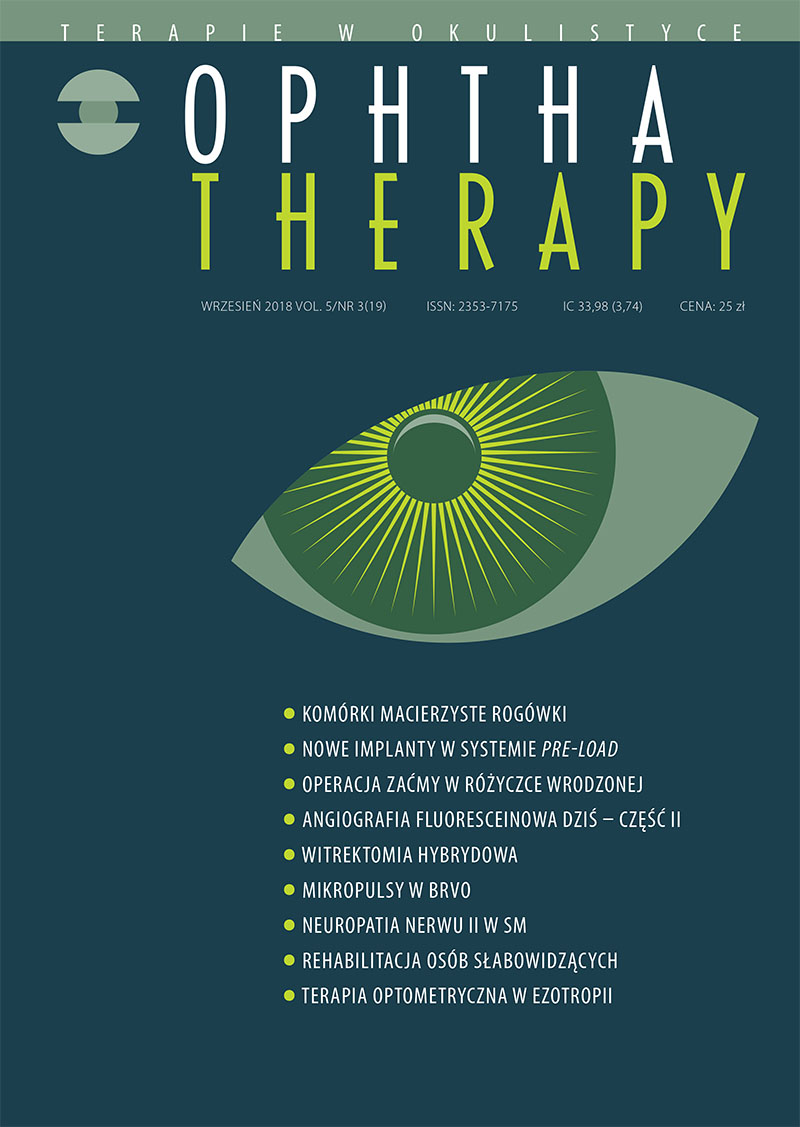Optic neuropathy in multiple sclerosis and other neurodegenerative diseases – diagnostics and therapeutic procedures
Main Article Content
Abstract
The etiology of multiple sclerosis (MS) and other neurodegenerative diseases is very complex, thus it may be associated with multiple factors operating simultaneously or in cascade scheme. The essence of the disease is multifocal scattered damage to the central nervous system (CNS). The MS incidence varies 50/105–100/105 depending on latitude. Neurodegenerative diseases, dependent on the location of pathological focus areas, can produce a number of diverse ophthalmic symptoms. The authors present a contemporary look at the possibilities of diagnostic and therapeutic procedures in patients with selected neurodegenerative diseases, with particular attention to patients with optic neuropathy, in the course of MS, by emphasizing the role of ophthalmologist care and accentuating the importance of multidisciplinary co-operation in making a correct diagnosis.
Downloads
Article Details

This work is licensed under a Creative Commons Attribution-NonCommercial-NoDerivatives 4.0 International License.
Copyright: © Medical Education sp. z o.o. License allowing third parties to copy and redistribute the material in any medium or format and to remix, transform, and build upon the material, provided the original work is properly cited and states its license.
Address reprint requests to: Medical Education, Marcin Kuźma (marcin.kuzma@mededu.pl)
References
2. Catanzaro R, Anzalone M, Calabrese F et al. The gut microbiota and its correlations with the central nervous system disorders. Panminerva Med. 2015; 57(3): 127-43.
3. Haile Y, Deng X, Ortiz-Sandoval C et al. Rab32 connects ER stress to mitochondrial defects in multiple sclerosis. J Neuroinflammation. 2017; 14: 19.
4. Selmaj K. Stwardnienie rozsiane. Termedia, Poznań 2006: 10-22, 49, 64-5.
5. Bambo MP, Gracia-Martin E, Larrosa JM et al. Evaluation of optic nerve perfusion in optic neuropathies and neurodegenerative diseases. Arch Soc Esp Oftalmol. 2015; 90(4): 153-5.
6. Brown K, DeCoffe D, Molcan E et al. Diet-induced dysbiosis of the intestinal microbiota and the effects on immunity and diseases. Nutrients. 2012; 4: 1095-119.
7. Pula JH, Reder AT. Multiple sclerosis. Part 1: Neuro-ophthalmic manifestations. Curr Opin Ophthalmol. 2009; 20: 467-75. https://doi.org/10.1097/ ICU.0b013e328331913b .
8. Baker LJ, Miller DH, Reingold SC et al. Vision and vision-related outcome measures in multiple sclerosis. Brain. 2015; 138: 11-27.
9. Akaishi T, Nakashima J, Takeshital T et al. Different etiologies and prognoses of optic neuritis in demyelinating diseases. J Neuroimmunol. 2016; 299: 152-7.
10. Torres-Torres R, Sanchez-Dalmau BF. Treatment of acute optic neuritis and vision complaints in multiple sclerosis. Curr Treat Options Neurol. 2015; 17: 328.
11. Kupersmith MJ, Garvin MK, Wang JK et al. Retinal ganglion cell layer thinning within 1 month of presentation for optic neuritis. Mult Scler. 2016; 22(5): 641-48.
12. Bernstein SL, Miller NR. Ischemic optic neuropathies and their models: disease comparisons, model shenaths and meakness. Jpn J Ophthalmol. 2015; 59: 135-47.
13. Trobe JD. Rapid Diagnosis in Ophthalmology: Neuro-Ophthalmology. Mosby, UK/USA 2008: 23-83.
14. Nordmann JP. OCT and optic nerve Non-glaucomatous optic neuropatienes. La poratoire Thea 2016: 88-115.
15. Bisht B, Darling WG, Grossmann RE et al. A multimodal intervention for patients with secondary progressive multiple sclerosis: feasibility and effect on fatigue. J Altern Complement Med. 2014; 20(5): 347-55.
16. Ghadiri N, Emamnia N, Ganjalikhani-Hakemi M et al. Analysis of the expression of mir-34a, mir-199a, mir-30c and mir-19a in peripheral blood CD4+T lymphocytes of relapsing-remitting multiple sclerosis patients. Gene. 2018; 659: 109-17.
17. Cennamo G, Romano MR, Vecchio EC et al. Anatomical and functional retinal changes in multiple sclerosis. Eye. 2016; 30(3): 456-62.
18. Hamurcu M, Orhan G, Sarıcaoğlu MS et al. Analysis of multiple sclerosis patients with electrophysiological and structural tests. Int Ophthalmol. 2017; 37(3): 649-53. https://doi.org/10.1007/s10792-016-0324-2.
19. AL-Louzi OA, Bhargava P, Newsome SD et al. Outer retinal changes following acute optic neuritis. Mult Scler. 2016; 22(3): 362-72.
20. Sühs KW, Papanagiotou P, Hein K et al. Disease activity and conversion into multiple sclerosis after optic neuritis is treated with Erythropoietin. Int J Mol Sci. 2016; 17: 1666.
21. Pojda-Wilczek D, Wycisło-Gawron P. The effect of the decrease in intraocular pressure on optic nerve function in patients with optic nerve drusen. Ophthalmic Res. 2017 Oct 31. https://doi.org/10.1159000481534.
22. Iester M, Altieri M, Michelson G et al. Retinal peripapillary blood flow before and after topical brinzolamide. Ophthalmologica. 2004; 218: 390-6.
23. Barnes GE, Li B, Dean T et al. Increased optic nerve head blood flow after 1 week of twice daily topical brinzolamide treatment in Dutch-belted rabbits. Surv. Opthalmol. 2000; 44(suppl 2): 131-40.
24. Reese D, Shivapour ET, Wahls T et al. Neuromuscular electrical stimulation and dietary interventions to reduce oxidative stress in a secondary progressive multiple sclerosis patient leads to marked gains in function: a case report. Cases J. 2009; 2: 7601.

